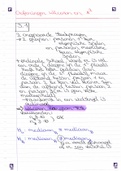Summary
Summary Exam 1 Translational Neuroscience (Med-Min16)
- Course
- Institution
This summary is for the first written exam of the medical minor Translational Neuroscience (Med-Min16). The lectures are summarized that are needed for the first exam. Included are pictures to help with grasp everything.
[Show more]









